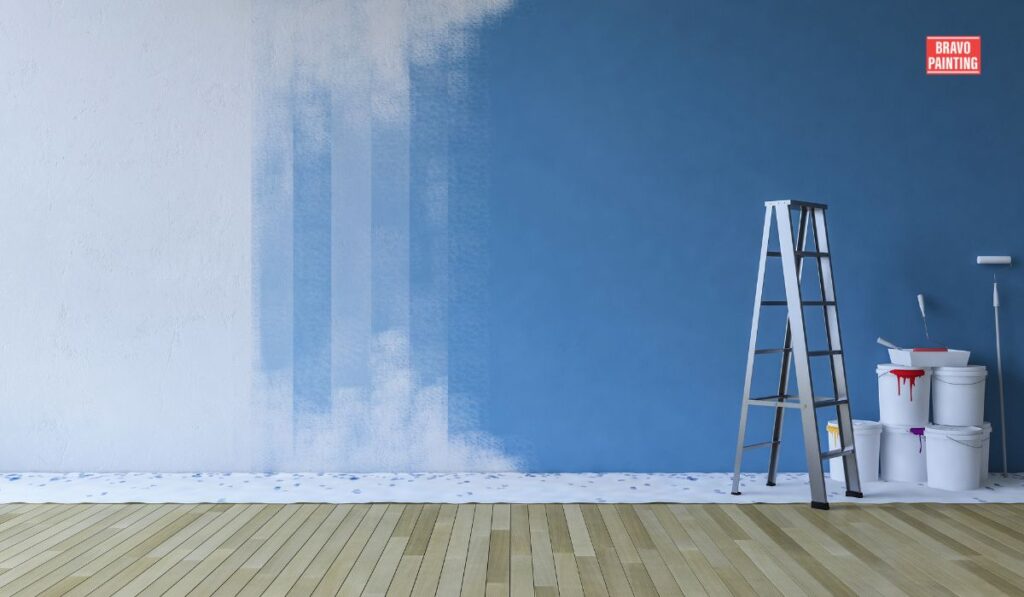The interior paint of your house serves as more than just a protective layer—it’s a powerful tool for transforming your living spaces into vibrant, personalized sanctuaries.
Whether you’re aiming to create a cozy retreat, a modern haven, or a bold statement, creative paint ideas can revitalize your home and reflect your unique style.
This article explores various techniques, color psychology insights, and practical tips to help you unleash the full potential of interior house paint.
Understanding Color Psychology
Before delving into specific paint ideas, it’s essential to understand the psychological impact of colors on our emotions and perceptions.
Colors can significantly influence the mood and atmosphere of a room:
- Warm Colors: Shades like reds, oranges, and yellows are known for their energizing and stimulating effects. They can create a sense of warmth and intimacy, making them ideal for social spaces like living rooms or dining areas.
- Cool Colors: Blues, greens, and purples evoke feelings of calmness and relaxation. These hues are perfect for bedrooms or study areas where tranquility is desired.
- Neutral Colors: Whites, grays, and beiges offer versatility and timeless elegance. They provide a neutral backdrop that allows furniture and decor to stand out, making them suitable for any room in the house.
Choosing the right color palette involves considering both personal preferences and the intended purpose of the space.
For instance, combining warm and cool tones can create balance and visual interest.
Trending Paint Colors for 2024
Staying updated with current trends can inspire your paint choices and ensure your home feels modern and stylish.
Here are some trending colors for 2024:
- Nature-Inspired Hues: Earthy tones such as sage green, terracotta, and ocean blue are gaining popularity.
These colors bring the serenity of nature indoors, fostering a connection to the outdoors within your home.
- Bold Statements: Vibrant shades like mustard yellow, deep teal, and rich burgundy are making a comeback.
These colors add drama and personality to a room, making them ideal for accent walls or statement pieces of furniture.
- Timeless Neutrals: Classic neutrals like white, dove gray, and taupe remain a staple in interior design.
They provide a clean, sophisticated backdrop that complements any decor style, from minimalist to traditional.
Experimenting with different shades within these color families can help you find the perfect hue that resonates with your aesthetic vision.

Creative Painting Techniques
Beyond choosing colors, exploring creative painting techniques can elevate the visual appeal of your walls and add depth to your interiors:
- Ombre Effect: Gradually blending one color into another creates a subtle, gradient effect that adds dimension to any room.
This technique works well in bedrooms or living rooms, where a soft transition of colors can enhance relaxation.
- Textured Finishes: Techniques like sponge painting, rag rolling, or stippling create textured surfaces that add tactile interest to walls.
These techniques are particularly effective in creating a rustic or Mediterranean-inspired atmosphere.
- Geometric Patterns: Using painter’s tape to create geometric shapes or stripes can transform a wall into a work of art.
This modern approach adds a contemporary flair to spaces like home offices or children’s rooms.
Mixing and matching these techniques across different rooms can create a cohesive yet dynamic interior design scheme that reflects your creativity.
Accent Walls and Feature Paintings
Accent walls serve as focal points that draw attention and highlight architectural features or decorative elements:
- Color Blocking: Painting one wall in a bold, contrasting color can create a striking focal point. This technique works well in rooms with architectural features like alcoves or fireplace surrounds.
- Mural or Stencil Art: Custom-designed murals or stenciled patterns can add personality and charm to any room. Whether it’s a whimsical design in a nursery or a sophisticated pattern in a dining room, artful walls can become conversation pieces.
- Metallic Accents: Incorporating metallic paints or foils adds a touch of luxury and sophistication to your interiors. Metallic accents can be applied sparingly as highlights or used to create entire accent walls that shimmer and reflect light.
Choosing the right wall for an accent and carefully planning the design ensures that your accent wall enhances the overall aesthetic of the room without overwhelming the space.
Choosing the Right Paint for Your Needs
Selecting the appropriate paint type and finish is crucial for achieving desired results and ensuring longevity:
- Paint Types: Water-based paints are eco-friendly and dry quickly, while oil-based paints provide a durable finish suitable for high-traffic areas. Choose a paint type that suits the specific requirements of each room.
- Finish Options: Matte finishes create a soft, velvety appearance that conceals imperfections but may require more maintenance. Satin and eggshell finishes offer a subtle sheen that is easy to clean and ideal for living rooms or kitchens. Gloss finishes are highly durable and suitable for doors, trims, and cabinets.
- Environmental Considerations: Opt for low-VOC or zero-VOC paints to minimize indoor air pollution and promote healthier living environments. These paints are particularly beneficial for households with children, pets, or individuals with sensitivities.
Consulting with paint specialists or interior designers can provide valuable insights into choosing the right paint products and finishes that align with your aesthetic goals and practical needs.
Tips for Painting Success
Achieving professional-looking results requires careful preparation, meticulous application, and attention to detail:
- Preparation: Clean walls thoroughly to remove dirt, grease, and old paint. Repair any cracks or holes with spackle and sand surfaces smooth before applying primer.
- Application Techniques: Use high-quality brushes and rollers for smooth, even coverage. Start painting from the top of the wall and work your way down, allowing each coat to dry completely before applying the next.
- Finishing Touches: After painting, inspect for missed spots or uneven areas and touch up as needed. Remove painter’s tape carefully to avoid peeling off fresh paint, and clean brushes and rollers promptly with soap and water or appropriate solvents.
Taking the time to prepare properly and execute each step with precision ensures that your paint job not only enhances the aesthetic appeal of your home but also withstands the test of time.
Conclusion
In conclusion, creative interior house paint ideas offer endless possibilities for transforming your living spaces into personalized sanctuaries that reflect your style and personality.
Whether you opt for bold statement colors, textured finishes, or artistic accents, each paint choice contributes to the overall ambiance and functionality of your home.
By understanding color psychology, exploring trending hues, experimenting with painting techniques, and choosing the right products, you can revitalize your space and create an environment that inspires and rejuvenates.
Embrace the transformative power of paint and embark on a journey to reinvent your home one brushstroke at a time.
Your living spaces await their masterpiece—let your creativity flow and make your house a true reflection of you.
Ready to transform your home with creative paint ideas?
Visit Bravo Painting to discover expert painting services and premium paint products that will bring your vision to life.
FAQs
How does interior house paint impact the overall ambiance of a room?
Interior house paint serves as more than just a protective layer; it can significantly influence the mood and atmosphere of a room. Warm colors like reds and oranges create a sense of warmth and intimacy, ideal for social spaces. Cool colors such as blues and greens evoke calmness and relaxation, perfect for bedrooms or study areas. Neutral colors like whites and grays offer versatility and elegance, providing a neutral backdrop that complements various decor styles.
What are some trending paint colors for 2024?
Trending paint colors for 2024 include nature-inspired hues such as sage green, terracotta, and ocean blue, which bring the serenity of nature indoors. Bold statement colors like mustard yellow, deep teal, and rich burgundy are also popular for creating dramatic accents or focal points. Timeless neutrals such as white, dove gray, and taupe remain classic choices that suit any interior design theme.
How can creative painting techniques enhance the visual appeal of walls?
Creative painting techniques such as the ombre effect (gradual blending of colors), textured finishes like sponge painting or rag rolling, and geometric patterns created with painter’s tape add depth and character to walls. These techniques can transform ordinary walls into works of art, contributing to a dynamic and personalized interior design scheme.
What are accent walls and how can they be effectively used?
Accent walls are walls painted in a different color or with a unique design to serve as focal points in a room. They highlight architectural features like alcoves or fireplace surrounds and can showcase artwork or decorative elements. Techniques like color blocking, mural or stencil art, and metallic accents can all be used to create striking accent walls that enhance the overall aesthetic of a space.
How should one choose the right paint type and finish for different rooms?
Selecting the right paint type and finish is crucial for achieving desired results and ensuring longevity. Water-based paints are eco-friendly and dry quickly, while oil-based paints offer durability, making them suitable for high-traffic areas. Matte finishes conceal imperfections but may require more maintenance, while satin and eggshell finishes provide a subtle sheen that is easy to clean. Gloss finishes are highly durable and ideal for doors, trims, and cabinets.
What environmental considerations should be taken into account when choosing paints?
Environmental considerations include opting for low-VOC (volatile organic compound) or zero-VOC paints to minimize indoor air pollution and promote healthier living environments. These paints are particularly beneficial for households with children, pets, or individuals with sensitivities to chemicals. Consulting with paint specialists or interior designers can provide additional guidance on choosing paints that align with both aesthetic preferences and environmental concerns.
What are some essential tips for achieving professional-looking paint results?
To achieve professional-looking paint results, thorough preparation is key. This includes cleaning walls to remove dirt and old paint, repairing any imperfections, and applying primer before painting. Use high-quality brushes and rollers for even coverage, and follow proper application techniques such as starting from the top of the wall and working downwards. Inspect for missed spots or uneven areas after painting, and touch up as needed. Removing painter’s tape carefully and cleaning tools promptly ensures a clean and polished finish.
Blog, Interior Painting

